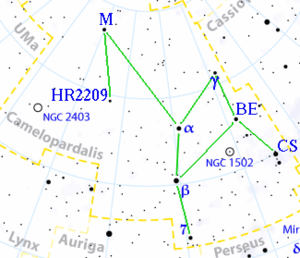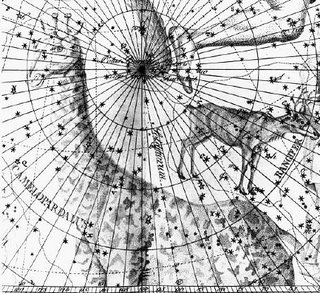Giraffe picture.. Camelopardalis
 Ok, this one's a bit of a stretch, but there is a giraffe there if you look, whilst tilting your head 45 degrees to the left. Although Camelopardalis is the 18th largest constellation, it is not a particularly bright constellation, but the stars of the constellation can be connected in such a way, which will graphically show a giraffe.
Ok, this one's a bit of a stretch, but there is a giraffe there if you look, whilst tilting your head 45 degrees to the left. Although Camelopardalis is the 18th largest constellation, it is not a particularly bright constellation, but the stars of the constellation can be connected in such a way, which will graphically show a giraffe.
The giraffe's body consists of the quadrangle of stars α Camelopardalis, β Camelopardalis, BE Camelopardalis, and γ Camelopardalis: α and β Camelopardalis being of the fourth magnitude.
The stars HR 2209 and M Camelopardalis form the head of the giraffe, and the stars M Camelopardalis and α Camelopardalis form the giraffe's long neck. Stars beta Camelopardalis and 7 Camelopardalis form the giraffe's front leg, and variable stars BE Camelopardalis and CS Camelopardalis form the giraffe's hind leg.
The constellation of Camelopardalis was included
in the educational game "Uranias Mirror" which was designed by a young lady in the early 19th Century in Great Britain to teach children and amateur astronomers the star charts.
Each of the 32 cards show a constellation and the stars that comprise it as would be visible in England. The stars are represented by small holes punched right into the card, with bigger holes to represent brighter stars. So, to learn the formation of the constellations, one would hold the cards up to a light source and see the bright holes representing the star positions. The light is diffused by tissue paper attached to the back of the card.
Camelopardalis had also initially appeared in a work
titled the "Uranographia" by Johann Bode in 1801, which Bode produced whilst working as director of the Berlin Observatory.
In size, this was the largest star atlas that had ever been published. The positions of more than 17,240 stars are given, shown over 20 star maps in a format aimed to show both artistic impression of the constellation figures but also with scientific accuracy. This work is regarded as the first reasonably complete depiction of the stars visible to the human eye.
Many thanks to:
http://www.ianridpath.com/startales/camelopardalis.htm
http://www.philaprintshop.com/leigh.html
The constellation of Camelopardalis was included

in the educational game "Uranias Mirror" which was designed by a young lady in the early 19th Century in Great Britain to teach children and amateur astronomers the star charts.
Each of the 32 cards show a constellation and the stars that comprise it as would be visible in England. The stars are represented by small holes punched right into the card, with bigger holes to represent brighter stars. So, to learn the formation of the constellations, one would hold the cards up to a light source and see the bright holes representing the star positions. The light is diffused by tissue paper attached to the back of the card.
Camelopardalis had also initially appeared in a work

titled the "Uranographia" by Johann Bode in 1801, which Bode produced whilst working as director of the Berlin Observatory.
In size, this was the largest star atlas that had ever been published. The positions of more than 17,240 stars are given, shown over 20 star maps in a format aimed to show both artistic impression of the constellation figures but also with scientific accuracy. This work is regarded as the first reasonably complete depiction of the stars visible to the human eye.
Many thanks to:
http://www.ianridpath.com/startales/camelopardalis.htm
http://www.philaprintshop.com/leigh.html
No comments:
Post a Comment